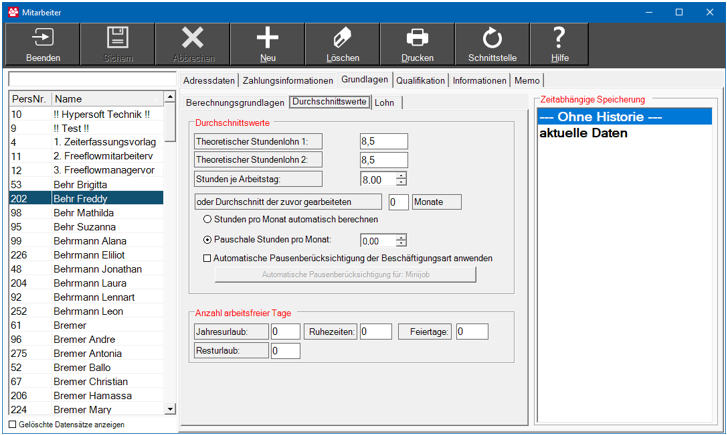Staff Basics
The Basics section contains three tabs, Calculation Basics, Average Values, Wage. Regarding the processing of historical data, see the chapter Historical employee data.
Calculation bases in the employee master record

| Element / Switch | Function / Description |
|---|---|
| 5/6/7 days week |
This setting is used as the calculation basis for the flextime balance. Further documentation: Flexitime balance |
| Days not available |
If an employee should not or cannot work on certain days, you can define this by selecting the corresponding days. Unavailable days are signalled by a grey background colour in the holiday planner and do not count as a holiday day in the case of leave (comparable to the treatment of weekends with regard to employees working on weekdays). When scheduling the employee in the Hypersoft duty roster, a warning message appears if the employee is scheduled on such days. |
| place of action |
The place of use is the default for the use of the Shift management and time recording. |
| Commission wage type | The commission wage type is used for the PAISY wage type. |
| Employment type | Wage earners or salary earners can be used in the wage type configurator to control specific wage types. |
Average values in the employee base

| Element / Switch | Function / Description |
|---|---|
| Theoretical hourly wage |
For evaluations (to determine the theoretical wage costs), the field theoretical hourly wage is multiplied by the work duration. See also Best practice with theoretical hourly wage 1 and 2. Further documentation: Basis for calculation of theoretical wage costs or hourly wage |
|
and |
This information is used to determine the hours in case of absences. Result = days times number of hours. The number of hours per workday is also used in the duty roster and is automatically used when entering the planned working time. The value Flat-rate hours per month is used as the basis for determining overtime. The Report Manager provides you with a detailed overview in the time recording report. However, you can also use the average of the last 3 (or other number) months. The average number of hours is displayedin the vacation planner. The wage type configurator must be set up correctly for this. Further documentation: |
|
Automatically calculate hours per month or Flat rate hours per month |
Select whether the hours per month should be calculated automatically. The hours are calculated according to the number of days in the month and the target hours. Public holidays are also taken into account. You can specify a number of hours per month. |
| Use automatic break consideration for employment type |
With this switch, individual employees can receive their break regulations independently of the activity. With the button below you reach the setting of the pause consideration. In this example the one of the Gleitzone:
|
| Number of non-working days |
The leave entitlement in days is valid for the current employee per year. You receive an evaluation with the leave planner in the employee year overview. The information on rest periods and holiday periods is stored for information purposes and is not used further. The remaining leave can be processed here per employee or also in tabular form for several employees and is described in the section Remaining leave after the turn of the year. |
Wages in the employee master record
To use the entries in this area for time recording, activate in the wage type configurator Take employee settings into account.

| Element / Switch | Function / Description |
|---|---|
| type of employment |
The selection of the employment type affects the time calendar. At Minijob, the latter checks compliance with the wage limit and maximum working hours.
|
| Use global settings |
The German maximum values for the working duration per day, week, month, and year are stored in the system. You can adjust the defaults in the staff settings at duration of work. Alternatively, you can set these values per employee here. While updates can change the global values, your manual values are preserved. You may then have to take changes in the law into account yourself at this point. |
| Allowed overhead types | Tax-free supplements are divided into types. You can specify which bonuses each employee is to receive. |
| Recurring working hours | Here you can store recurring working times for each employee. These can be entered automatically if you want to save individual employees from having to enter the times manually. In the time calendar, you can simply have these defaults entered. |
Further documentation: Wage type configurator
Back to the parent page: Use employee master record
